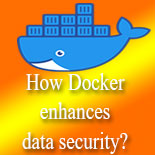Docker Data Security: How Docker enhances data security?
Docker, the most advanced containerisation technology for software app development is preferred by developers across all types of projects simply as a low footprint and more performance savvy alternative to virtual machines. From developers to system administrators to the enterprise strategists, all are full of praise for the Docker technology. But even Docker is not less vulnerable to security attacks and issues. This is why the open source developer community is coming with advanced security controls for Docker. According to latest development, experts have come up with a layered security approach combining a variety of coherent security controls for protection of data and resources.
Understanding the layered security approach for Docker
To strengthen the data security developers are now increasing the barriers to the maximum to prevent any possible breakout. The idea is to utilise as much Linux based security mechanisms as possible. Linux platform is equipped with a plethora of security features such as file system protections that can be changed as "read-only".
On the other hand, Docker ones with copy-on-write file systems that prevent one container to see the changes in another container. Docker also enhances security by removing several key capabilities that can cause security issues. Apart from that Docker namespaces also enhance the security. For example, the PID namespace is capable of hiding many processes running on a system and network namespace can be used for implementing security rules related to routing and network uses.
Multi Category Security (MCS) is a protocol in Docker that helps protect one container from the security threats from other containers. By enforcing MCS, separate containers can be managed and protected independently from each other. This ensures that when a container is hacked it cannot penetrate and contaminate other containers.
Evolving security practices for Docker
Since Docker emerged as the most valuable container technology with a lot of promises for the developers as well as administrators, Docker is here to stay. Hence improving the security features of Docker is so important in order to utilise the full potential of the technology.
Apart from all these new tools and improvements, maintaining best security practices is equally important for safeguarding Docker. Some of the best security practices for Docker technology include the following:
- Running apps from only trusted sources.
- Running apps on a enterprise grade hosting provider
- Availing and installing updates on a regular basis
- Minimising privileges
- Keeping watch on data and activity logs
The above mentioned practices have been tested and tried by developers across projects. Developers who have successfully utilised the potential of Docker for their app projects found these practices really helpful. Though Docker security practices continue to evolve and get better with inputs from the open source developer community, the above mentioned practices continue to stay viable for a multitude of app projects.
Data security in Docker environment (a must-have)
This is another security requirement and an important one while you are deploying your application in Docker container. To ensure that a Docker image is safe it is must to secure your Docker image be enabling the Docker security, which is actually enabled by default. You can run your Docker image with appropriate security options that fits your application requirement.
The Docker communication can be secured by implementing TLS security options. In the official documentation of Docker, you'll find information on how to configure the docker image to use TLS for secure communication. This is an option to ensure that communication between the Docker container and the underlying host is never exposed to attackers. Docker supports TLS 1.2 according to the OpenSSL Project, which industry standard security mechanism for securing the application communications.
You can also use the public-key authentication mechanism for security your application communications. For the other two security requirements you can choose to secure your container by using public-key authentication instead of TLS (which makes up the majority of the modern container security policies). This is still a popular security measure and Docker's documentation defines exactly what it means. It's a pretty cool option which you might use for your applications. If you are deploying lots of web-services or micro-services than security your applications communications is must.
Security in Docker images
Docker itself has a security feature that will warn you about a potential security vulnerability.
It can be disabled in your Dockerfile by providing -Dsecurity=false.
Docker Tutorials and helpful articles
Check following tutorial and articles:
